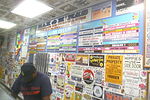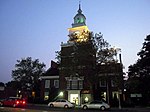Yeshivas Ohr HaChaim

Yeshivas Ohr Hachaim is a Haredi yeshiva located in Kew Garden Hills, Queens, New York City. The yeshiva also has a kollel, and operates in conjunction with its high school Mesivta Yesodei Yeshurun which is located next door to Yeshivas Ohr Hachaim. The current Rosh Yeshiva is Rabbi Doniel Lander and the Rosh Kollel is Rabbi Shmuel Rabinovici. Both are former students of the revered Rabbi Joseph B. Soloveitchik of Yeshiva University. The yeshiva building is prominently located on Main Street in Kew Gardens Hills. The building is noted for its exterior, which is primarily made of Jerusalem stone (so named for being both common and legally required for construction in Jerusalem) imported from Israel specifically for the building.Rabbi Mordechai Kraus was one of the Roshei Yeshiva until his passing in 2016.
Excerpt from the Wikipedia article Yeshivas Ohr HaChaim (License: CC BY-SA 3.0, Authors, Images).Yeshivas Ohr HaChaim
71st Avenue, New York Queens
Geographical coordinates (GPS) Address Nearby Places Show on map
Geographical coordinates (GPS)
| Latitude | Longitude |
|---|---|
| N 40.728075 ° | E -73.822802777778 ° |
Address
71st Avenue 141-57
11367 New York, Queens
New York, United States
Open on Google Maps








